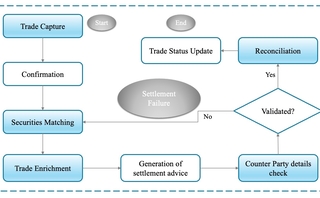Tomorrow’s institution cares more about its risk than its performance
Execs from BlackRock, BMO, and Ness Digital Engineering discuss the balancing act of the wildly shifting priorities each of their organizations contend with every day.

For every step forward, it seems there’s one, or even two or three, back. Such is the nature of innovation and its unintended consequences. AI has given the world ChatGPT and virtual reality, but it’s also created deepfakes and led to a mountain range of auto-generated online disinformation. Cloud has made data storage easier and cheaper than ever before, but has prompted real concerns around privacy, security, and 24/7 reliability.
It’s these double-edged swords that keep Aishwarya Venkatesan, BlackRock’s head of data strategy and analytics for global trading, up at night. She said she believes that risk, above anything else, has to be the biggest focus for any financial institution hoping to survive the 21st century.
“In terms of risk vs. performance, I think especially given all the advancements in AI and data and what’s coming in, risk has to be number one,” said Venkatesan, speaking at the North American Financial Information Summit (Nafis), held by WatersTechnology last week in Manhattan.
She also emphasized the need for top-tier controls as organizations move more toward emerging over-the-counter (OTC) products, where pricing and liquidity are murky at best. “To me, risk is absolutely number one. But I believe if you build good risk systems and you have good traders, then the performance is going to come,” she said.
Sri Ganesan, global head of financial services at Ness Digital Engineering, who also spoke at Nafis, shared Venkatesan’s focus on risk. The world is changing, and with it, risk is changing. Where derivatives risk has been largely standardized, the forthcoming implementation of the Fundamental Review of the Trading Book (FRTB) will change the game, he said.
FRTB, an international standard governing the amount of capital banks must hold against market risk exposures, is currently set to be implemented at the start of 2025, alongside the projected launch date for Basel III in the US. But it’s been repeatedly delayed since the Covid-19 pandemic first derailed its timeline in early 2020.
“The dataset is going to be almost nine times what you produce today for market risk,” Ganesan said.
The problem of heightened risk, however, begets the opportunity for further innovation. Ganesan said that with an exploding universe of data out there, there’s a growing market need for better data visualization tools. “How do you bring that massive dataset in front of you, to the consumers—in a way that they can use?” he said.
On the same Nafis panel, Kim Jaffee-Prado, chief information officer of US capital markets at BMO Financial Group, said it used to be a world where there just wasn’t enough data; now, there’s too much of it. In trying to manage and minimize “the firehose effect,” as she called it, BMO has set out to institutionalize its client reference data, security reference data, and even people data. “I mean, how many places don’t really know who works there?” Jaffee-Prado said.
The strategy involves taking table-stakes structured data and tying it together with the exhaust that comes from all the execution platforms. For example, there are more than 45 request-for-quote channels within the Fixed Income Clearing Corp. (FICC) alone, she said, with clients in and out all day, trying to buy and sell securities. If an organization isn’t capturing that data, and syncing it with its people data, that adds up to a lot of missed trades and a missed opportunity for better understanding your clients and their goals.
“All that inquiry that fell on the ground—you tie that then with [knowing] that client went to this conference and is looking for that bond. Well, we’re not pricing that bond. Why not? We should be,” Jaffee-Prado said.
Banks and asset managers already walk a thin line in managing alpha-generating activities, incoming and changing regulations, client-facing operations, and just keeping pace with peers. As technology solves yesterday’s problems, it creates tomorrow’s headaches, one data point at a time.
Further reading
Only users who have a paid subscription or are part of a corporate subscription are able to print or copy content.
To access these options, along with all other subscription benefits, please contact info@waterstechnology.com or view our subscription options here: http://subscriptions.waterstechnology.com/subscribe
You are currently unable to print this content. Please contact info@waterstechnology.com to find out more.
You are currently unable to copy this content. Please contact info@waterstechnology.com to find out more.
Copyright Infopro Digital Limited. All rights reserved.
You may share this content using our article tools. Printing this content is for the sole use of the Authorised User (named subscriber), as outlined in our terms and conditions - https://www.infopro-insight.com/terms-conditions/insight-subscriptions/
If you would like to purchase additional rights please email info@waterstechnology.com
Copyright Infopro Digital Limited. All rights reserved.
You may share this content using our article tools. Copying this content is for the sole use of the Authorised User (named subscriber), as outlined in our terms and conditions - https://www.infopro-insight.com/terms-conditions/insight-subscriptions/
If you would like to purchase additional rights please email info@waterstechnology.com
More on Emerging Technologies
Quants look to language models to predict market impact
Oxford-Man Institute says LLM-type engine that ‘reads’ order-book messages could help improve execution
The IMD Wrap: Talkin’ ’bout my generation
As a Gen-Xer, Max tells GenAI to get off his lawn—after it's mowed it, watered it and trimmed the shrubs so he can sit back and enjoy it.
This Week: Delta Capita/SSimple, BNY Mellon, DTCC, Broadridge, and more
A summary of the latest financial technology news.
Waters Wavelength Podcast: The issue with corporate actions
Yogita Mehta from SIX joins to discuss the biggest challenges firms face when dealing with corporate actions.
JP Morgan pulls plug on deep learning model for FX algos
The bank has turned to less complex models that are easier to explain to clients.
LSEG-Microsoft products on track for 2024 release
The exchange’s to-do list includes embedding its data, analytics, and workflows in the Microsoft Teams and productivity suite.
Data catalog competition heats up as spending cools
Data catalogs represent a big step toward a shopping experience in the style of Amazon.com or iTunes for market data management and procurement. Here, we take a look at the key players in this space, old and new.
Harnessing generative AI to address security settlement challenges
A new paper from IBM researchers explores settlement challenges and looks at how generative AI can, among other things, identify the underlying cause of an issue and rectify the errors.








